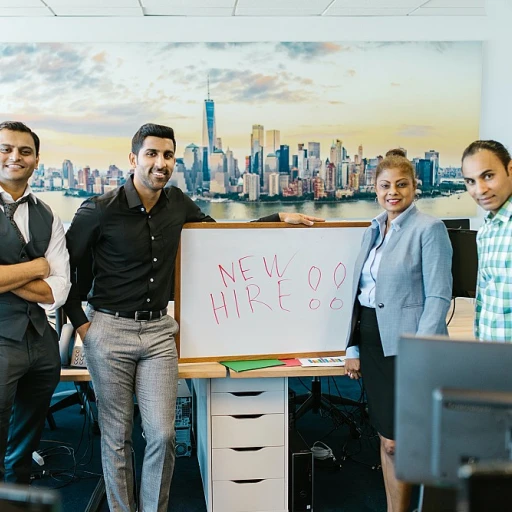
Understanding the Profile of a Potential Candidate
Defining the Ideal Candidate Profile
Understanding the profile of a potential candidate is a cornerstone of any effective talent acquisition strategy. It begins with identifying the specific skills and qualities good candidates must possess to thrive in the job role. This involves a deep dive into the job title and the responsibilities associated with it. A comprehensive job description is essential, as it helps both the organization and potential candidates align their expectations.
Identifying Key Skills and Qualities
When determining the profile of a high potential candidate, consider both hard and soft skills. Hard skills are often role-specific and can be assessed through technical tests or practical tasks during the interview process. Soft skills, such as communication and teamwork, are equally important and can be evaluated through behavioral interview questions. This balanced approach ensures that the candidate not only fits the technical requirements but also aligns with the company culture.
Utilizing Data and Insights
Data-driven insights can significantly enhance the selection process. Leveraging technology to analyze past hiring data can reveal patterns and traits common among successful hires. This information can guide your team in refining the criteria for potential candidates. Additionally, conducting thorough background checks and using social media can provide a fuller picture of the candidate's professional experience and potential.
Continuous Learning and Adaptation
The hiring process is not static; it evolves with time and industry trends. It's a good idea to continuously learn from each hiring cycle and adjust the criteria for potential candidates accordingly. Engaging with industry experts and attending relevant workshops can also help your team stay updated on best practices. For more insights on navigating the landscape of potential candidates, explore our detailed guide on navigating the landscape of optometry careers.
Crafting a Compelling Employer Brand
Building an Employer Brand That Resonates
Creating a compelling employer brand is crucial in attracting the right potential candidates. This involves clearly communicating what makes your company a unique and desirable place to work. It's not just about listing job titles or roles; it's about showcasing the qualities good candidates look for in an organization.
Start by defining your company culture. What values does your organization uphold? How do these values translate into the work environment and employee experience? Candidates are increasingly looking for workplaces that align with their personal values and offer a sense of purpose. Highlighting these aspects can make your company more appealing to high potential candidates.
Utilizing Social Media and Online Platforms
Social media is a powerful tool in your talent acquisition strategy. It allows you to reach a wider audience and engage with potential candidates in a more informal setting. Share stories about your team, successes, and what a day in the life at your company looks like. This helps candidates visualize themselves as part of your organization.
Additionally, consider platforms where job candidates actively seek opportunities. Ensure your company’s presence on these platforms is strong and consistent. This can significantly enhance your ability to attract candidates who are a good fit for your company.
Showcasing Opportunities for Growth
Potential candidates are not just looking for a job; they are looking for a career. Highlight opportunities for professional development and growth within your company. Whether it's through training programs, mentorship, or clear career paths, showing that your organization invests in its employees' futures can be a major draw.
For more insights on enhancing your talent acquisition strategy, particularly for specific roles, consider exploring resources like enhancing talent acquisition for NDT customer support roles.
Leveraging Technology in Talent Acquisition
Utilizing Advanced Tools to Enhance Recruitment Efficiency
In talent acquisition, the approach to finding and engaging potential candidates has been significantly enhanced by leveraging technology. The adoption of new tools and platforms streamlines the process of identifying job candidates who align with your organization’s needs. One of the key technologies is Applicant Tracking Systems (ATS), which provide an efficient way to manage the hiring process from start to finish. These platforms enable you to track applicants, organize data, and refine the selection process based on specific criteria such as skills and experience. Incorporating ATS into your hiring strategy can save considerable time and help refine the pool of high potential candidates. Social media has also become an essential tool in connecting with potential candidates. Platforms like LinkedIn offer opportunities to reach individuals with the right skills and qualities good for your organization. Additionally, leveraging job boards and specialized recruitment websites can expand your reach across different sectors and job titles. Furthermore, the integration of Artificial Intelligence (AI) in recruitment strategies is transforming how organizations conduct interviews and evaluate candidates. AI-powered tools can help curate a list of questions based on the role, streamline background checks, and even assess soft skills to predict a candidate's fit within the company culture. For companies seeking to build a diverse talent pool, technology can also play a pivotal role. By incorporating technologies that highlight key diversity metrics, organizations are better equipped to understand and foster inclusive work environments. For more insights, consider embracing diversity and inclusion with a strategic calendar, which aligns with advancing tech-driven talent acquisition strategies. Ultimately, by leveraging these technological advances, your organization can build a more effective, efficient, and inclusive hiring process, ensuring you identify and engage with the best potential candidates for your team.Building a Diverse Talent Pool
Fostering a Rich Talent Mix
Building a diverse talent pool is crucial for any organization aiming to thrive in today’s competitive market. It involves more than just ticking boxes; it’s about enriching your company culture and enhancing the overall hiring process. A diverse team brings varied perspectives, which can lead to innovative solutions and a more dynamic work environment.
To start, identify the qualities good potential candidates should have, focusing on both hard and soft skills. This approach will help you cast a wider net and attract a variety of job candidates. The selection process should be inclusive, ensuring that every potential candidate feels valued and considered. It's a good idea to use interview questions that assess a range of skills and experiences, allowing candidates to showcase their unique strengths.
Inclusive Hiring Practices
Incorporating inclusive hiring practices is essential. This means ensuring that your interview process is free from bias and that your job descriptions appeal to a broad audience. When crafting these descriptions, avoid jargon that may deter potential candidates from applying. Instead, focus on the core skills and experiences required for the role.
Utilize technology to aid in this process. Tools that help in assessing candidates based on skills rather than backgrounds can be invaluable. This approach not only streamlines the hiring process but also ensures that you are considering a diverse range of candidates.
Engaging a Broad Audience
Engagement is key when building a diverse talent pool. Use social media and other platforms to reach out to potential candidates from various backgrounds. Highlight your organization’s commitment to diversity and inclusion in your employer brand. This will not only attract high potential candidates but also enhance your company’s reputation as an inclusive employer.
Remember, building a diverse talent pool is an ongoing process. Regularly review your hiring strategies and make adjustments as needed. This proactive approach will help your organization remain competitive and innovative in the long run.
Engagement Strategies for Passive Candidates
Strategies to Reach Passive Candidates
Engaging passive candidates is often a game-changer in the hiring process, particularly when you are aiming to hire high potential individuals who aren't actively seeking new opportunities but could be the perfect fit for your organization. Uncovering these hidden gems requires a strategic approach that delves beyond traditional candidate searches. Firstly, identifying potential candidates with the right skills and experience for your organization can largely depend on leveraging social media platforms, industry-specific forums, and professional networks. Investing time in curating a network where potential candidates are likely to engage or share insights can provide an edge. Craft content that resonates with the values and the culture of your company, attracting those who share similar professional ambitions. Understanding the needs and desires of these candidates can greatly enhance your talent acquisition arsenal. Here's where crafting a compelling employer brand, as discussed earlier, plays a pivotal role. Establishing your company as a desirable place to work will naturally attract talent, creating a longer waiting list of interested individuals. Diversifying your candidate outreach strategies is crucial. Different candidates may respond to different forms of engagement. Hosting webinars or informational sessions about new roles or company culture can provide a less formal avenue for passive candidates to learn about your organization, effectively warming them up. Develop interview questions that highlight soft skills and personal qualities good candidates should possess. This will help in identifying those who align with your organizational values. Moreover, based hiring techniques focus not just on the resume, but also on a holistic view of the candidate's potential. When it comes to the interview process, consider offering flexible times for discussions, as passive candidates may need time to navigate their current responsibilities. Open-ended questions in this setting encourage potential candidates to share broader insights into their career aspirations and how they might align with your company. In conclusion, reaching passive candidates and converting them into potential hires is no easy feat. However, with an engaging approach and a strong understanding of what your organization offers, you can significantly enhance your talent pool. Ultimately, adopting innovative engagement strategies is a good idea that can lead to a more diverse and capable workforce.Measuring the Success of Your Talent Acquisition Strategy
Tracking and Analyzing Key Metrics
The process of measuring the success of your talent acquisition strategy is a crucial step that ensures you are aligning with your company's long-term goals. To gauge the effectiveness, start by tracking key performance indicators (KPIs) that are directly linked to the hiring process.- Time-to-hire: Evaluate how quickly your organization can move a candidate through the entire hiring process, from the job title posting to the acceptance of an offer.
- Quality of hire: Measure the output and integration of new recruits. The qualities good potential candidates bring should align with your company's expectations and role requirements.
- Candidate experience: Gather feedback from job candidates regarding their journey. How smooth was the application and interview process? Assessing their experience will provide insights into refining the selection process.
- Interview-to-offer ratio: Understanding this ratio helps identify how efficiently your organization sees through interview questions and selects suitable candidates.
- Retention rate: A high turnover might indicate an issue either with the employee selection or company culture. This metric reflects if newly hired employees are staying with the company for a significant period.












